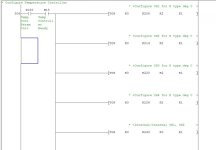Stevolution
Member
Hello all
Life long electrician, and been playing with a Mitsubishi FX3U-64M + FX3U-4LC PID controller. Its installed and programmed in a piece of failed equipment, so having a play.
Using the GP Pro Ex software that I found in the office to set up a remote screen.
I am having a little trouble triggering screen 'pop-ups' using D-Scripts for that remote screen.
I have the script for opening a new base screen upon my requirements, but I need to open a window or trigger another feature (such as a message display).
I need to show a message when 4x values are over a preset value (hence using a D-script).
Is there a list of available D-script commands? I know that will be a long list! If not, what reference material would direct me in the right direction?
I am learning this from scratch myself, so lots of Google searches have already happened.... and I am making good progress.
Thanks, Steve
Life long electrician, and been playing with a Mitsubishi FX3U-64M + FX3U-4LC PID controller. Its installed and programmed in a piece of failed equipment, so having a play.
Using the GP Pro Ex software that I found in the office to set up a remote screen.
I am having a little trouble triggering screen 'pop-ups' using D-Scripts for that remote screen.
I have the script for opening a new base screen upon my requirements, but I need to open a window or trigger another feature (such as a message display).
I need to show a message when 4x values are over a preset value (hence using a D-script).
Is there a list of available D-script commands? I know that will be a long list! If not, what reference material would direct me in the right direction?
I am learning this from scratch myself, so lots of Google searches have already happened.... and I am making good progress.
Thanks, Steve






